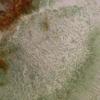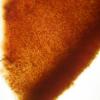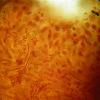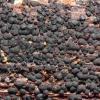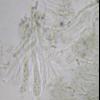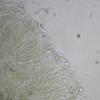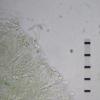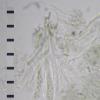
24-12-2025 17:08
Hulda Caroline HolteHello, I have found this propoloid ascomycete on

21-12-2025 09:32
Hello.A tiny ascomycete found embedded in wood in

21-12-2025 21:32
Pol DebaenstHello, Garden, Burgweg 19, Veurne, BelgiumOn 10/1

22-12-2025 23:38
Patrice TANCHAUDBonsoir, récolte sur un mur en pierre, apothéci

22-12-2025 00:47
Patrice TANCHAUDBonsoir, récolte à proximité du milieu dunaire
Here's already my next problem:
Substrate: (Yet) Unidentified deciduous wood
Macro: Apothecia, up to 0.5 mm diam. (as single apothecia), exceeding 1 mm in confluent parts. Densely aggregated and often more or less coalescing to confluent parts. Black, with a distinct margin when young, then flat without margin and later convex. Exuding as a red-brown colour in KOH.
Micro: The whole disc is incrusted with a brown substance and structures are difficult to see when prepared in water. This Substance dissolves in KOH as a reddish exsudate and then the structures are hyaline to distinctly green. Asci 35-40 x 5 µm, IKI-, Melzer-, Spores hyaline, 4.5-5.5 x 1.2-1.6 µm, with two oildrops, aseptate. Paraphyses about 1 µm diameter. Excipulum not clearly differentiated from medulla, the medulla consisting of gelatinous tissue with loosely intertwined, irregularly expanded hyphae (Photos).
Thank you for any help
Stefan

Ist was Durelloides.

danke, das hilft! Vergleiche mal meine Zeichnungen im Verzeichnis Phaeangella = Durella redbrown, und da "bigutt spores narrow ionom". Da sind zwei Funde, einer aus USA, der andere aus Luxemburg. Die wuchsen aber an ansitzenden Ästen.
Hast du keine Skala in deinen Fotos? Dann könnte ich etwas nachmessen.
Das Auflösen und Austreten des rotbraunen Pigments ist typisch für diese Art (ionomidotisch). Irgendwie erinnert er auch an Ionomitodis fulvotingens, aber nur mikroskopisch inklusive Excipulum.
Grüße
Zotto

Asci tot 45 x 4.5-5.5 µm,
Sporen etwa 4,5-5,5 x 1,8-2 µm
